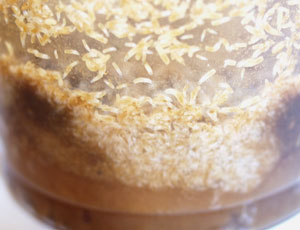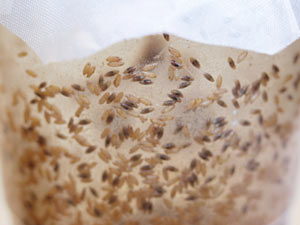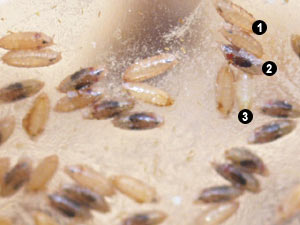Fruit flies are an excellent food for many surface feeding killifish, closely resembling their natural diets in the wild. They are easy to culture, quickly, cheaply and in large numbers. Fruit flys are rarely available in pet shops, but are widely available online, and very much worth trying, even if you don't bother culturing them on an ongoing basis.
What is a fruit fly?
Fruit flies are small flies that live on and around decaying fruit and vegetation. They occur worldwide, except the very coldest regions. The species most familiar to scientists, aquarists and herpetologists are in the genus Drosophila which literally means 'dew-lover' in Greek. Also known as 'bar fly' or 'vinegar fly', these little flies are commonly found around waste bins, bars, orchards etc, and they are widely used in laboratories as research animals. The species we feed to our fish however, have been bred to have shorter 'vestigial' wings, and as such can not fly. These are typically from two species Drosophila melanogaster and Drosophila Hydei.
Why fruit flies?
Although dealing with highly mobile flies can be trickier than with worms, there are some great reasons to consider culturing them.
- Nutritious - all fish can be trained to eat flies, but surface feeders love them. Not only are they relished by the fish, but they also have a high fibre content, and are therefore a great contrast to the fattier foods such as worms and beef heart. They are also typically disease-free, unlike some aquatic livefoods.
- Prolific An adult fly can lay 20+ eggs in a day. Once you get the hang of it, fruit flies are easy to maintain, and at 25 deg. centigrade the development of Drosophila melanogaster takes just 9 days.
- Availability - unlike collected livefoods, cultured Drosophila are available all year round.
- Flightless flies available - fruit flies have been studied in laboratories for very many years, and a lot is known about the humble fruit fly. Over the course of these studies, geneticists line-bred many strains of fly, including vestigial-winged, and even wingless flies. These are the flies typically cultured by hobbiests.

Drosophila larvae in a typical culture

Drosophila larvae climb up the walls of their vials and chrysalise

Drosophila pupae
Drosophila life cycle
Adult flies lay a lot of eggs. A single female can lay over 20 eggs in a day, and can store sperm within her body for up to two weeks, to lay fertilized eggs at will.
Eggs take 23 hours to hatch at 25 deg C. Once they do hatch, the larvae bury into the media and grow. They will stay as larvae for five days, in which time they undergo three moults.
Eventually they will start to climb the sides of the vial, and when fully grown will settle near the top, and form a chrysalis. The change from maggot to fly takes around three days, but again, is temperature dependent.
The image to the right shows a newly formed chrysalis with the lava's segments still visible (1), an older chrysalis with the fly clearly visible. The red dots are its eyes (2) and an empty chrysalis from which a fly will have hatched (3).
Once the flies have emerged they must be moved to new vials, as there is now no food suitable for them in the old vials.
Fruit fly cultures for sale
Killi.co.uk is funded by its visitors. When you buy through links on our site we may earn an affiliate commission. For more info see
terms and conditions.
Gadsden, Alabama, 359**, UNITED STATES OF AMERICA
$35
This kit contains 10 cups / lids, media that works for both Hydei and Melangaster flies, and excelsior In each 32 oz cup add 1 / 2 cup of media, pour 3 / 4 cup of boiling filtered water, mix well. When media is mixed well add excelsior and cover with lid. Please wait for media to cool before adding in your flies (not included in kit). Keep at room temperature....
more
Catlett, Virginia, 201**, UNITED STATES OF AMERICA
$16
Flightless Fruit Fly Culture (Drosophila Hydei)...
more
Wichita, Kansas, 672**, UNITED STATES OF AMERICA
$12
32oz Flightless Fruit Fly Culture.
...
more
San Diego, California, 921**, UNITED STATES OF AMERICA
$16
Buy Drosophila melanogaster Wingless Fruit Fly Cultures - Ideal Feeder Insects for Reptiles & Amphibians
Searching for the perfect live feeder insect for your small reptiles and amphibians? Our Drosophila melanogaster wingless fruit fly cultures are the top choice for feeding dart frogs, baby chameleons, mantises, and other small insectivores. These wingless fruit flies are easy to manage and provide a nutritious, protein-rich diet essential for your pet??s health and growth
Why Choose ...
more
Dover, Pennsylvania, 173**, UNITED STATES OF AMERICA
$30
This package contains four cultures of Turkish Gliders Fruit Fly, perfect for feeding your pet reptiles, including dart frogs. These fruit flies are a delicious and nutritious food source that will keep your pets healthy and happy
Each culture contains a large number of fruit flies, ensuring that you will have enough food for your pets for a while. The package is designed for pet owners who are looking for a high-quality food source for their pets
...
more


